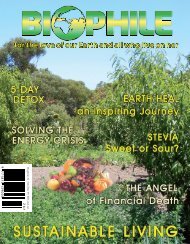Soil for LifeSheet MulchGardeningBuild your soil the‘no work’ waySoil for Life is a Cape Town-based NGOwhich teaches people to grow theirown food. For more information aboutSoil for Life membership, and organicmethods for growing vegetables, herbsand fruit, please phone Pat on (021) 7944982Sheet mulching (or composting)is the simplest, and least labourintensive, method of building thefertility of most soil types andaffords the gardener an easier optionthan back-breaking spade workfor establishing a new garden. Itencourages the soil biota, many speciesof which will work the soil over for you -no digging required. It is a three-in-onemethod which combines composting,mulching and biodegradableweedkillers (cardboard and newspaper),and it enables you not only to improveyour soil but to grow and harvest a cropall at the same time.There are many ways of sheet mulching,two of which are discussed. Bothrequire enormous volumes of organicmatter initially and, thereafter, it becomesa routine activity in the gardento keep adding more mulching materialsto the surface as the soil floraand fauna break them down intolife-sustaining humus, and releasingnutrients which are gobbledup by the plants. The whole ideabehind it is to minimise soildisturbance.Here’s how to go about it:Method 1• Mark out the areas for yournew beds and, right on top ofwhatever is there (bare soil,weeds, grass), sprinkle somerock phosphate or bonemealand wood ash or dolomitic lime(for acid soils) or sulphur (for thosealkaline Cape Flats soils).• Cover the area with a layer of manureto provide the extra nitrogen to breakdown the dead leaves and roots of theplants that will be buried by the mulchingmaterials.• Then add alternating layers (6cm, or3 fingers, deep) of green, wet materials(lawn clippings, fresh leaves and prunings)and brown, dry materials (untreatedsawdust, autumn leaves, straw)and more manure, watering each layeras you go, until you have covered thedemarcated area to a depth of at least20cm. With vigorous Kikuyu grass it is agood idea to mulch the area up to 30 or40 cm deep. You’ll be surprised at howmuch organic matter it takes to do this.• Cover the whole area with overlappingsheets of newspaper (3 – 5 sheets) orcardboard (1- 3 sheets) to prevent weedseeds from germinating, and grass runnersfrom creeping through, and competingwith your plants. Wet the paperand cardboard thoroughly and, in a veryshort space of time, it will have rotteddown and disappeared, its job done.• Lastly, add a layer of compost, soil andmulch to hide the unsightly newspaperand, hey presto, you’re ready to plant.Make a hole in the mulch/soil layer, cuta cross through the paper or cardboard,add a dollop of good potting mix (halfcompost, half good garden soil) andplant your seed or transplant your seedling.Water well.Method 2• Mark out the areas for your new bedsand cover whatever is there (bare soil,weeds, grass) with between three tosix sheets of newspaper or one to threesheets of cardboard. Make sure thesheets are overlapping well and water.• Now proceed as above, layering green,wet and brown, dry materials and manureuntil the bed area is covered to adepth of at least 20 cm.• Add a layer of mulch to cover.• To plant up this sheet mulched area,simply make a hole in the mulch, add agood soil mix and plant.In both cases there is no need to useherbicides or other drastic measuresto kill the grass and other vegetation.The newspaper and cardboard will doit for you. A myriad different creatureswill take up residence in this bountifulenvironment, enriching the soil beneathwith valuable humus which willbe worked in by earthworms and otherorganisms which are, in effect, diggingthe soil for you.60 <strong>Biophile</strong> Issue <strong>16</strong>
Food from treesOur indigenous trees are a good sourceof food; they’re both beautiful, andbountiful.Wild fruits have an exceptionally highvitamin C content – partly what makesthem so acid – and sometimes a highprotein, fat, carbohydrate or mineralcontent.Global warming and climatechange are topics that are repeatedlydiscussed in the media andamongst concerned citizens ofPlanet Earth.And so they should be. Yet too fewpeople seem sufficiently motivatedto make a lasting and positive impacton these disturbing trends by changingtheir lifestyles even a smidgen. Itdoesn’t have to be a drastic, life-alteringchange. It can be as simple and rewarding,as planting a tree, or two, or three?Trees benefit the ecosystems of theworld by providing habitats for manycreatures that play significant roles inmaintaining the balance of nature. Theyfertilise and look after the soils, absorbmassive quantities of carbon dioxide,release life-giving oxygen, and absorbthe rainfall and slowly release it backinto the atmosphere or into groundwater supplies. They provide the magic,medicine and poison that minister tothe mind and spirit of man; fuel, timber,shade and shelter and, not least ofall, food provide for the physical bodywhich is, perhaps, more important inthe minds of many people.Our indigenous trees are a sourceof all these things, but let’s take alook at trees as a potential source ofnourishment.Over hundreds of years the wild treesin this country have provided sustenance– the difference between hungerand plenty, life and death, for peopleand their livestock, and for the wild animalswhich they hunted and on whichthey fed. Today, with our so-calledsophisticated tastes, many of these treefoods are unappealing to the palate.I was intrigued recently to see thenumber of folk – young and old - climbingon neighbourhood walls, and hangingprecariously off the boughs of thetrees planted along the length of oneof the main roads in our seaside villagein Cape Town. I stopped to investigate.The centre of interest was the beautifulplum-coloured fruits of the waterberry– also known as Waterbessie (Afrikaans),umdoni (Xhosa, Zulu), montlho (NorthernSotho) and (more technically) Syzigiumcordatum – whichwere growing in profusionon these rathersplendid trees.I tasted the fruits,somewhat takenaback that I hadnever noticed thembefore, and waspleasantly surprisedat the sweetnessof the obviouslyripe ones, and thesour and tangy taste ofthose still to reach their prime.Syzigium cordatum – the waterberrytree – belongs to the familyMyrtaceae along withthe various guavas,pomegranates andAustralian gums.Most people are alsofamiliar with thecommon Eugeniaused as a hedgingplant. We’ve all usedallspice and clovesin the kitchen. Theseare the aromaticfruits and flowerbuds respectively ofother members of this same family, andwhich have great commercial value inAsia.The waterberry is an evergreen, waterlovingtree occurring fairly widely inSouth Africa and in a wide range of habitatsranging from forest margins, alongwater courses, in open bush and rockyoutcrops, and from sea level to altitudesof 1 600 metres. It reaches heights of 12to 18 metres, the larger specimens beingfound in swamp forests where theyhave been described as being ‘literallysupported on top of quagmires by thetremendous spread of their roots’.Waterberries are dense with round orspreading canopies and are often moreluxuriant at the coast where the air ismore humid, and water tables may behigher. In fact, it is believed that thepresence of these trees in the wild indicatesthe presence of ground water. Theblue-green leaves are thick and leathery,well able to tolerate the gale-forcewinds in the South-Western Cape andnew foliage is bright red which addsto the aesthetic appeal of the tree. Inthe wild, browsing animals such as theKudu eat the leaves and there are certainlybirds such as the Crowned Hornbillwhich indirectly benefit by feedingoff the hairy caterpillars of moths andbutterflies that sometimes infest it oc-Syzigium cordatumca-sionally.In early spring and summer theclusters of sturdy buds at the ends ofthe branches burst into creamy-whiteor pink flowers which drop their petalsvery quickly leaving little puffs ofstamens. The flowers have a delicatescent, produce large amounts of nectarand provide a good food source for beesand other insects. In late summer andautumn, the fleshy, deep pink to purpleberries ripen, each one with one pipand these provide food for humans anda variety of animals including monkeys,birds, tortoises and mice.This tree is perhaps one of themost useful in our arboreal anthology:• It provides nesting sites and habitatsfor a variety of wild life.• Its bark provides a reddish-brownor orange dye, is used as an emetic andto treat stomach complaints and diarrhoea.Powdered bark is also used as afish poison.• The leaves and roots are used forSoil for Life runs monthlyworkshops in Cape Town on allaspects of organic gardening. Checkour website (www.soilforlife.co.za)for details of these workshops. Bookearly to avoid disappointment!<strong>Biophile</strong> Issue <strong>16</strong>61
















